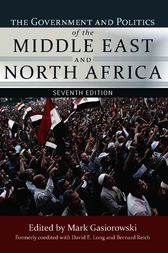|
Reviewed by: Dr. Shaul Bartal, Department of Political Science, Bar-Ilan University This book sums up Middle Eastern politics, serves as an introduction for beginners on the government and politics of the Middle East, and can be used as a reference and point of departure for the specialist. The exercise of power and authority between government and society is the key to understanding the book’s descriptions. This book is edited well. It divides the Middle Eastern states into three geographic areas: A. Mashriq: (From the Arabic which means eastern countries.) This group includes the Syrian Arab Republic, the Republic of Lebanon, the Hashemite Kingdom of Jordan, the State of Israel, Palestine, and the Republic of Turkey. B. Persian Gulf: This includes the Republic of Iraq, the Islamic Republic of Iran, the Kingdom of Saudi Arabia and the Eastern Arabian States — Kuwait, Bahrain, Qatar, the United Arabs Emirates, Oman, and the Republic of Yemen. C. Maghrib: (From the Arabic. This refers to the North African countries.) These include the Arab Republic of Egypt, the State of Libya, the Republic of Tunisia, the People’s Democratic Republic of Algeria and the Kingdom of Morocco. The description of each state begins with historical background, the social and political environment, the foreign policy and the state’s future prospects. It concludes with a full and rich bibliography of each state. Unfortunately, the attempt to examine future prospects sometimes fails. For example: The Assad regime remains securely in power in Damascus, but in the short term, its authority shows no signs of returning to areas controlled by the Islamic State or opposition group.(p. 75). In the last two years, since Russian intervention in the civil war, Assad forces included Hezbollah and other Shīʿah militias supported by Iran. These forces succeeded in re-conquering areas such as Aleppo (December 2016) and Dayr az-Zūr from the Islamic State and other opposition groups. The chapter describing Palestine seems a little artificial and totally ignores the Jewish history of the land jumping straight to the 19th century and the appearance of Zionism. The historical backgrounds of Israel and Palestine were one up until 1948. The Jews were the majority in Palestine since the days of King David’s Kingdom (from the 1,000 BCE to the 6th century BCE) and up until the last Jewish revolt against Constatius Gallus Caesar of the Eastern Roman Empire in the 4th century. The last Jewish State in Palestine existed during the Simon Bar-Kokhba revolt or the third Roman-Jewish War (131-136 CE). During the British Mandate in Palestine, the Jews slowly became thirty percent of the population. In July 1937, the Palestine Royal Report suggested a partition plan for the first time. This plan gave the Jews only seventeen percent of the land (with a much bigger Jordan). Another commission headed by Sir John Woodhead suggested an even more mini-Jewish state. The Palestinians refused all partition plans ever suggested to them. It is strange that the two chapters dealing with Israel/Palestine do not mention the first partition plan of Lord Peel and its consequences up until today. As Boris Johnson put it: “No doubt that the only viable solution to the conflict resembles the one first set down on paper by another Briton, Lord Peel, in the report of the Royal Commission on Palestine in 1937, and that is the vision of two states for two peoples.” The 1949 armistice lines between Israel and Jordan shaped what became the West Bank of the Hashemite Kingdom of Jordan and the armistice with Egypt shaped the Gaza Strip. According to Mira Sucharov and Hamed Mousavi: “While some Jews have always resided in the area, the overwhelming majority lived elsewhere from the time of the Roman expulsion in 70 CE.” (p. 137). Jews were always a part of Palestine’s history. Today’s Palestinians are not descendants of the Jewish tribes that some controversial studies and Glenn Robinson suggested. (p. 173) And the Palestinians are only one of many stateless people in the Middle East. Also unfortunate is that the chapter on the Eastern Arabian States written by Jill Crystal includes four independent and recognized states in just one chapter. Each state should have been a separate chapter. More space is needed to enable a more comprehensive discussion regarding Qatar and its oil investments, Al-Jazeera, and its complicated relationships with its neighboring states. Iran’s relationships with Hamas and Israel also deserve more space and its own chapter. Bahrain, with its internal tension due to a society made up of both Shīʿites and Sunni’s also should have been given its own chapter. During the last decades, Iran has become the prime source of instability in the Middle East. Iran’s contributions to the instability of the other states in the area and its promotion of terror organizations are not emphasized enough in this book. Missing are the details of Iran’s connections with Hamas, the Islamic Jihad, Hezbollah, the Alawite regime in Syria and other Shīʿah communities in Iraq, Yemen and Bahrain that are shaping Middle Eastern politics and local alliances between her opponents. For example, Lebanon’s Prime Minister Saad al-Hariri resigned due to Iranian and Hezbollah plots to kill him as they killed his father, Rafik al-Hariri, in 2005. To conclude, this book provides a very good introduction to the historical background, politics and society of the Middle East and despite its commissions could serve as an excellent guide to the region’s political landscape. |


 The Government and Politics of the Middle East and North Africa
The Government and Politics of the Middle East and North Africa
